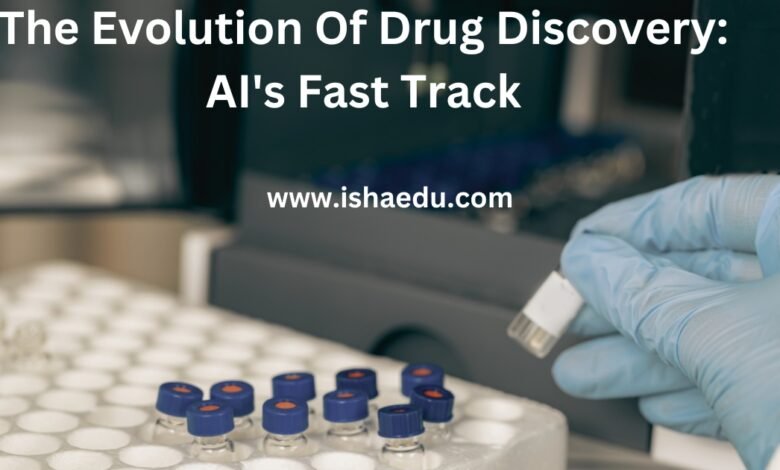The Evolution Of Drug Discovery: AI’s Fast Track

The Evolution Of Drug Discovery: AI’s Fast Track
Throughout history, humanity has battled diseases with a relentless pursuit of effective treatments. From ancient herbal remedies to modern pharmaceutical marvels, medical progress has been fueled by a quest for healing. However, the traditional path to discovering new drugs has been fraught with challenges slow, costly, and uncertain.
In recent times, artificial intelligence (AI) has emerged as a transformative force in drug discovery, promising to reshape how we approach medication development. By harnessing AI’s analytical prowess, pattern recognition capabilities, and predictive powers, researchers are unlocking novel pathways to expedite the creation of life-saving therapies.
The Traditional Drug Discovery Journey
Before delving into AI’s potential, it’s essential to grasp the hurdles entrenched in traditional drug discovery methods. This intricate process typically unfolds in several stages:
- Target Identification: Scientists invest years in pinpointing molecules or biological pathways relevant to disease through rigorous research in genetics, biochemistry, and cell biology.
- Lead Discovery: Once a target is identified, researchers embark on exhaustive screening processes, testing millions of compounds to uncover potential drug candidates.
- Preclinical Development: Promising candidates undergo intensive testing in controlled environments, assessing both efficacy and safety in cell cultures and animal models.
- Clinical Trials: Successful candidates move into human trials, a meticulous process involving numerous phases and participants to evaluate safety, efficacy, and dosing.
- Regulatory Approval: Post-trials, drugs undergo stringent reviews by regulatory bodies like the FDA to ensure they meet safety and efficacy standards before entering the market.
This protracted journey can span over a decade, with significant costs and substantial failure risks at each stage, impeding progress and innovation.
AI’s Disruptive Influence on Drug Discovery
AI stands poised to disrupt and streamline this conventional framework, injecting efficiencies across various stages of the drug discovery pipeline:
- Target Identification: AI algorithms sift through vast datasets encompassing genetic, molecular, and clinical insights to identify potential drug targets swiftly and accurately.
- Lead Discovery: Leveraging AI’s computational power, researchers can screen millions of compounds virtually, expediting the identification of promising drug candidates and reducing costs.
- Drug Design: AI facilitates rational drug design, enabling researchers to craft targeted therapies with desired properties, potentially leading to more effective treatments with fewer side effects.
- Predictive Modeling: AI-driven predictive models, trained on extensive clinical trial data, aid in foreseeing drug safety and efficacy, helping prioritize promising candidates and averting late-stage failures.
- Drug Repurposing: AI’s analytical prowess can uncover new therapeutic applications for existing drugs, offering a faster, cost-effective route to developing treatments.
Real-World Applications of AI in Drug Discovery
AI’s impact transcends theory, with tangible examples illustrating its transformative potential:
- DeepMind AlphaFold: This AI program has revolutionized protein structure prediction, vital for drug design, thereby expediting drug discovery efforts.
- Insilico Medicine: Using AI, Insilico identifies and develops novel drug candidates, collaborating with pharmaceutical firms to tackle diseases like cancer and Alzheimer’s.
- BenevolentAI: Leveraging AI, BenevolentAI analyzes vast scientific and patient data to identify therapeutic targets and design innovative drugs across various disease areas.
Navigating Ethical Frontiers and Fostering Collaboration
While AI promises monumental strides in drug discovery, ethical considerations must accompany its deployment. Addressing biases in AI algorithms and ensuring responsible data usage are paramount. Additionally, fostering collaborative efforts between AI experts, researchers, and regulatory bodies will be pivotal in harnessing AI’s potential ethically and effectively.
Looking Ahead
As AI technology evolves, its impact on drug discovery is poised to intensify, heralding a new era of accelerated innovation and improved healthcare.

FAQs
What was the first AI drug discovery?
The first AI-designed drug entered human trials in June 2023. It’s being tested for a lung condition.
What is the AI in drug discovery program?
AI in drug discovery programs uses computers to analyze vast amounts of data to find new medications faster. They can help identify targets, design candidates, and predict how well they might work. This helps researchers make better decisions about which drugs to develop.
What are the 4 stages of drug discovery?
The 4 main stages of drug discovery are:
- Identify a target in the disease process.
- Look for candidate molecules that interact with the target.
- Test the most promising candidates in labs and then in people.
- Get regulatory approval to sell the drug.
How fast is drug discovery?
Drug discovery is slow, taking an average of 10-15 years. Testing for safety and effectiveness is crucial, and many potential drugs don’t make it.

دواؤں کی دریافت کا ارتقاء: تیز رفتار کے لیے مصنوعی ذہانت (AI)
صدیوں سے انسانیت بیماریوں سے لڑ رہی ہے اور موثر علاج تلاش کرنے کی مسلسل کوشش کر رہی ہے۔ قدیم جڑی بوٹیوں کے علاج سے لے کر جدید ادویات کے عجائبات تک، طبی میدان میں ترقی کو ہمیشہ بہتر علاج کی تلاش نے تقویت بخشی ہے۔ تاہم، نئی دوائیں دریافت کرنے کا روایتی طریقہ کئی چیلنجوں سے بھرا ہوا ہے – یہ سست، مہنگا اور غیر یقینی ہے۔
حالیہ دنوں میں، مصنوعی ذہانت (AI) ادویات کی دریافت میں ایک انقلابی قوت کے طور پر ابھری ہے، جو ادویات کو تیار کرنے کے ہمارے طریقے کو بدلنے کا وعدہ کرتی ہے۔ AI کی تجزیاتی صلاحیت، پیٹرن کی شناخت کی صلاحیت اور پیشن گوئی کی طاقت سے فائدہ اٹھاتے ہوئے، محققین نئی دوائیں بنانے کے عمل کو تیز کرنے کے لیے نئے راستے تلاش کر رہے ہیں۔
روایتی ادویات کی دریافت کا سفر
AI کی صلاحیتوں کو جاننے سے پہلے، روایتی ادویات کی دریافت کے طریقوں میں شامل رکاوٹوں کو سمجھنا ضروری ہے۔ یہ پیچیدہ عمل عام طور پر کئی مراحل میں تقسیم ہوتا ہے:
ہدف کی شناخت: سائنسدان جین کی ساخت، حیاتیات اور خلیوں کے بارے میں تحقیق کے ذریعے بیماری سے جڑے ہوئے سالموں یا حیاتیاتی راستوں کی نشاندہی کرنے میں سالوں لگا دیتے ہیں۔
ابتدائی دریافت: ایک بار ہدف کی شناخت ہو جانے کے بعد، محققین ممکنہ ادویات کی امیدواروں کو تلاش کرنے کے لیے لاکھوں مرکبات کے امتحان کا عمل شروع کرتے ہیں۔
ابتدائی نتیجہ کی ترقی: امیدوار دوائوں کا خلیوں اور جانوروں پر تجربات کے ذریعے موثر اور محفوظ ہونے کا جائزہ لیا جاتا ہے۔
کلینیکل ٹرائلز: کامیاب امیدوار ادویات انسانی تجربات میں چلی جاتی ہیں، یہ حفاظت، تاثیر اور خوراک کا اندازہ نے کے لیے ایک محتاط عمل ہے جس میں کئی مراحل اور شرکاء شامل ہوتے ہیں۔
سرکاری منظوری: تجربات کے بعد، ادویات کا سخت جائزہ لیا جاتا ہے تاکہ یہ یقینی بنایا جا سکے کہ وہ مارکیٹ میں آنے سے پہلے تحفظ اور تاثیر کے معیار پر پورا اترتی ہیں۔
یہ لمبا عمل ایک دہائی سے زیادہ عرصے تک جاری رہ سکتا ہے، جس میں ہر مرحلے پر اہم اخراجات اور ناکامی کا خطرہ ہوتا ہے، جو ترقی اور جدت کو روکتا ہے۔
ادویات کی دریافت پر AI کا اثر
AI روایتی ادویات کی دریافت کے طریقوں کو بدلنے اور اسے آسان بنانے کے لیے تیار ہے، جو ادویات کی دریافت کے عمل کے مختلف مراحل میں کارآمد ثابت ہو رہا ہے۔
ہدف کی شناخت: AI الگورتھم جین کی ساخت، سالمات اور بیماریوں کے بارے میں معلومات کے بڑے ڈیٹا سیٹس کا جائزہ لے کر ممکنہ ہدف کی شناخت تیزی اور درست طریقے سے کرتے ہیں۔
ابتدائی دریافت: AI کی کمپیوٹر کی طاقت کا فائدہ اٹھاتے ہوئے، محققین لاکھوں مرکبات کا مجازی طور پر جائزہ لے سکتے ہیں، جس سے امیدوار ادویات کی شناخت میں تیزی آتی ہے اور لاگت کم ہوتی ہے۔
اکثر پوچھے جانے والے سوالات
پہلی AI ڈیزائن کی گئی دوا کب دریافت ہوئی؟
پہلی AI کی مدد سے ڈیزائن کی گئی دوا جون 2023 میں انسانی تجربات کے لیے پیش کی گئی۔ اس کا امتحان پھیپھڑوں کے ایک عارضے کے لیے کیا جا رہا ہے۔
دواؤں کی دریافت کے پروگرام میں AI کیا ہے؟
دواؤں کی دریافت کے پروگراموں میں AI کمپیوٹر کا استعمال کرتے ہوئے بڑے پیمانے پر موجود ڈیٹا کا تجزیہ کرتے ہیں تاکہ نئی ادویات کو تیزی سے تلاش کیا جا سکے۔ AI ہدف کی نشان دہی، ممکنہ ادویات کی ڈیزائننگ اور ان کے کام کرنے کی صلاحیت کی پیش گوئی میں مدد کر سکتے ہیں۔ یہ تحقیق کرنے والوں کو یہ فیصلہ کرنے میں مدد دیتا ہے کہ کون سی ادویات تیار کرنی ہیں۔
دواؤں کی دریافت کے 4 مراحل کیا ہیں؟
دواؤں کی دریافت کے 4 اہم مراحل ہیں:
بیماری کے عمل میں ہدف کی نشاندہی کریں۔
ہدف کے ساتھ تعامل کرنے والے ممکنہ سالموں کو تلاش کریں۔
لیبارٹریوں اور پھر لوگوں پر سب سے زیادہ امیدوار ادویات کا ٹیسٹ کریں۔
دوا فروخت کرنے کے لیے حکومتی منظوری حاصل کریں۔
دواؤں کی دریافت کتنی تیز ہے؟
دواؤں کی دریافت ایک سست عمل ہے، جس میں اوسطاً 10-15 سال لگتے ہیں۔ حفاظت اور تاثیر کے لیے جانچ پڑتال ضروری ہے، اور بہت سی ممکنہ ادویات کامیاب نہیں ہو پاتیں۔

Join Us :
Click Here To Get Technology And Entertainment Notification:




